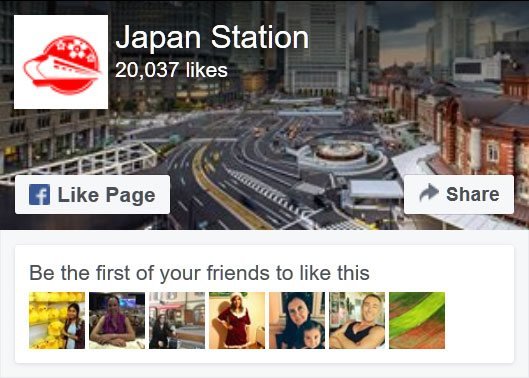Hankyu Railway are to introduce a companion train to their weekend “Kyo-Train” service which runs between Osaka and central Kyoto. The new sightseeing train is named “Kyo-Train Garaku”, and like the original Kyo-Train, it is designed to give passengers a taste of Kyoto’s special ambience from the moment they step on board. The new train will increase the number of tourist train services on the Hankyu Kyoto Line with each train running alternate hours.
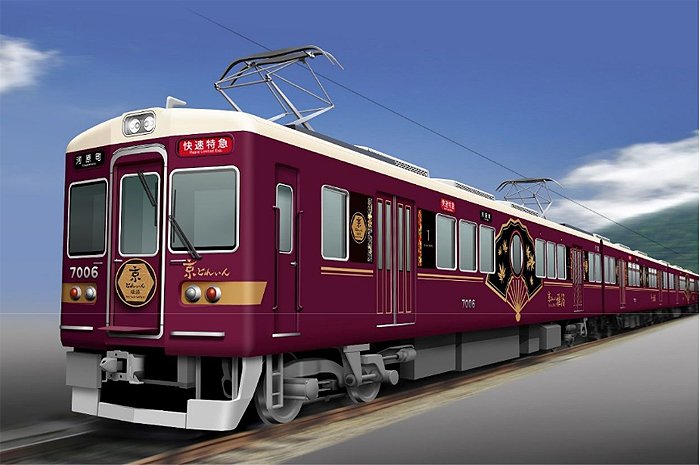
Kyo-Train Garaku will run weekend trips to Kyoto from March 2019
The current Kyo-Train, which has been running since 2011, is well known for its interior design which resembles that of an old-fashioned Kyoto machiya townhouse. The carriage décor employs wood paneling, wood-block printed wallpaper, tatami straw headrests, and washi paper posters to evoke the simple grace and craftsmanship of houses built for Kyoto’s merchant class.
The new train develops this appreciation for Kyoto’s traditional style, but with an added emphasis on refined elegance. The name “Garaku” is actually a newly minted word that combines the Japanese character for “refinement” with an old character for the imperial capital. The meaning is simply “elegant capital” but with a nuance suggestive of Kyoto’s ancient heritage. Whereas the first Kyo-Train reproduced the modest grace of a Kyoto home, Kyo-Train Garaku celebrates the full splendor of Kyoto’s 1,200 year history with motifs and elements lifted from seasonal festivals, temples, shrines and palaces.
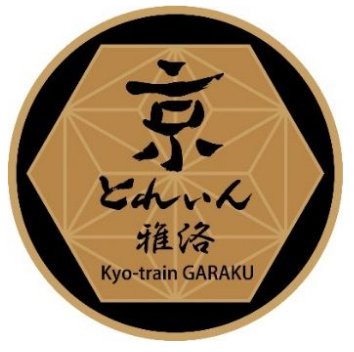
The Kyo-Train Garaku emblem
The Kyo-Train Garaku has six carriages, each with a separate seasonal theme as the basis for six unique exterior and interior designs. Throughout the train the interior seating is decorated with a variety of cloisonné style flower patterns.

Carriage one is decorated with maple leaves
The first carriage is inspired by autumn, with maple leaves on the outside, and an interior motif of fall foliage floating on water.
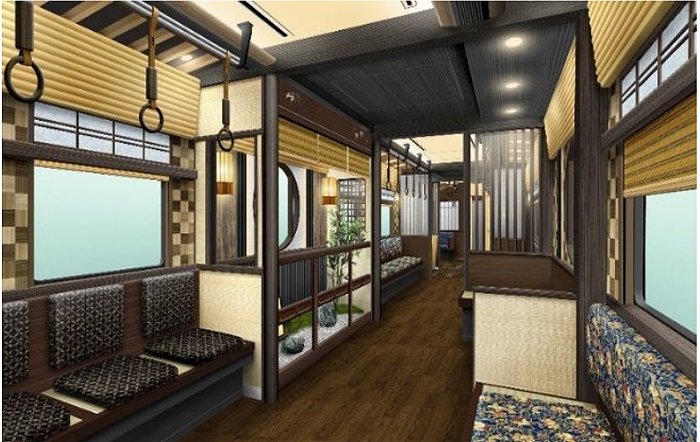
The interior of carriage 2. Both carriage 2 and 5 have their own interior gardens
The second carriage represents austere winter beauty, with a bamboo design on the outside, an interior rock garden, and special “snow-viewing windows” which are glass below and translucent shoji paper on top. The gentle beauty of a Kyoto spring is represented in the third carriage with a scattering of sakura petals both inside and out.
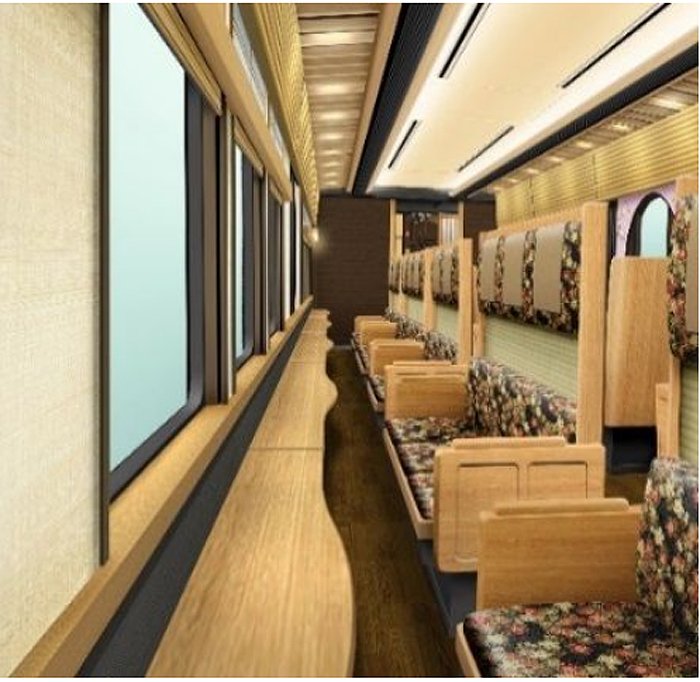
The interior of carriage 3. Carriages 3 and 4 have seats facing large windows so that passengers can enjoy an uninterrupted view of the Nishiyama mountain range.
The annual Aoi Festival is suggested by the hollyhocks on the fourth carriage’s exterior, and the irises on the inside are a beloved feature of Kyoto’s early summer. The fifth carriage depicts early autumn with waving susuki pampas grass bidding goodbye to summer, and the final carriage celebrates New Year and the oncoming spring with plum blossom.
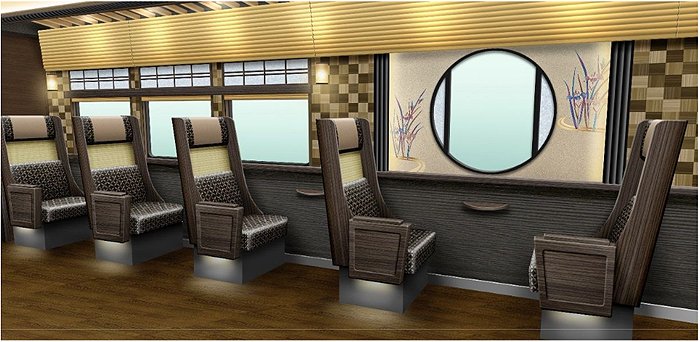
The iris decoration by carriage 4’s window. In the center of every carriage is a large circular window, a feature which is commonly seen in Kyoto’s temples and shrines.
For the benefit of international travelers, there will be tourist pamphlets and guide-maps in English, Chinese, and Korean on both versions of the Kyo-Train, and on-board announcements will be given in each language too. Free on-board Wi-Fi is also available, and as a special bonus Kyo-Train Garaku passengers can access a special “Garaku View” Wi-Fi service that will enable them to see the real-time view from the driver’s seat on their smart phones or computers.
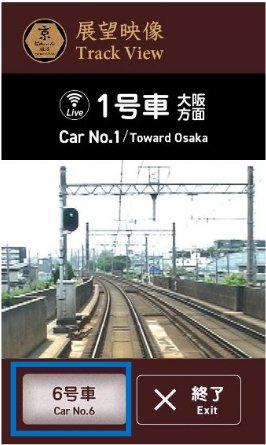
The Garaku View service is available in English and Japanese
The Schedule & Fare
The Kyo-Train Garaku is scheduled to begin weekend service operations between Hankyu Umeda Station in Osaka and Kawaramachi Station in Kyoto in March 2019. The new train will run alternate hours with the original Kyo-Train and together the two trains will run seven return services each day. Please note that these trains run only on weekends and public holidays. The services times are as follows:
| Times | 9.32 | 10.32 | 11.32 | 12.32 | 13.32 | 14.32 | 15.32 |
| Trains from Umeda | Kyo-Train Garaku |
Kyo-Train | Kyo-Train Garaku | Kyo-Train | Kyo-Train Garaku | Kyo-Train | Kyo-Train Garaku |
| Times | 10.41 | 11.41 | 12.41 | 13.41 | 14.41 | 15.41 | 16.41 |
| Trains from Kawaramachi |
Kyo-Train Garaku | Kyo-Train | Kyo-Train Garaku | Kyo-Train | Kyo-Train Garaku | Kyo-Train | Kyo-Train Garaku |
The Kyo-Train Garaku will stop at Umeda, Juso, Awaji, Katsura, Karasuma, and Kawaramachi. Passengers who wish to travel on to Arashiyama should transfer at Katsura Station. Passengers should also note that the original Kyo-Train does not stop at Juso.
The journey time between Umeda and Kawaramachi is under 45 minutes and the full fare for the trip on either train is just 400 yen. As this is the same as the regular fare for services on this line this is quite a bargain.
For a look inside the original machiya-style Kyo-Train check our previous article: Hankyu Railway’s “Kyo-Train” Mimics Kyoto Townhouse Interior Style
Article by Michael Lambe. All rights reserved.
